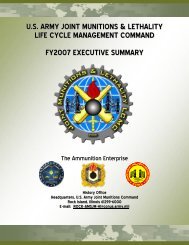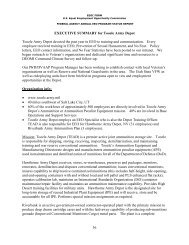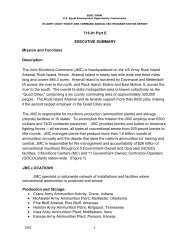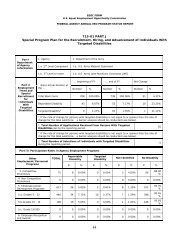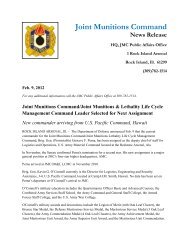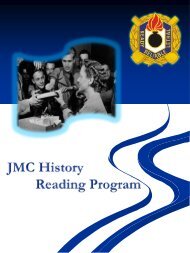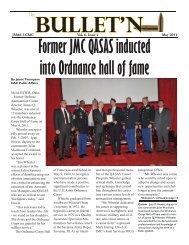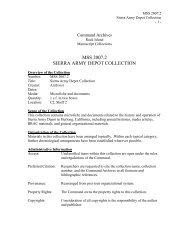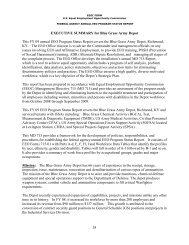History of the Ammunition Industrial Base - JMC - U.S. Army
History of the Ammunition Industrial Base - JMC - U.S. Army
History of the Ammunition Industrial Base - JMC - U.S. Army
Create successful ePaper yourself
Turn your PDF publications into a flip-book with our unique Google optimized e-Paper software.
<strong>Ammunition</strong> and to use multi-year money for contracting annual production and replenishment.<br />
They noted <strong>the</strong> boom-bust cycle <strong>of</strong> ammunition procurement made <strong>the</strong> marketplace too unstable<br />
for ammunition producers. PNNL found ammunition companies/producers were ei<strong>the</strong>r<br />
consolidating or leaving to find new markets with higher pr<strong>of</strong>it margins. Without pr<strong>of</strong>its<br />
commercial producers were foregoing capital investment in modernization, maintenance, and<br />
R&D. The government had also failed to invest in <strong>the</strong> base. The ammunition budget was held in<br />
low regard and was usually <strong>the</strong> bill-payer for o<strong>the</strong>r programs. PNNL also noted that <strong>the</strong> <strong>Army</strong><br />
had more sole source producers and less competition than at any time since before WWII.<br />
Despite <strong>the</strong> poor state <strong>of</strong> <strong>the</strong> ammunition base, PNNL believed <strong>the</strong> <strong>Army</strong> was capable <strong>of</strong><br />
producing peacetime and replenishment requirements. However, this was only because<br />
requirements were so low, <strong>the</strong> replenishment time-line was long, and <strong>the</strong> government base had so<br />
much excess capacity. They noted that <strong>the</strong> industrial base was in near-crisis state and changes to<br />
any <strong>of</strong> a number <strong>of</strong> variables could render <strong>the</strong> base incapable <strong>of</strong> meeting production<br />
requirements. 156<br />
From 1999-2002, <strong>the</strong> RAND Corporation conducted an extensive review <strong>of</strong> <strong>the</strong><br />
ammunition and industrial base. The main focus was on how to best privatize <strong>the</strong> munitions base<br />
(this included ammunition production as well as <strong>the</strong> manufacturing arsenals). RAND noted that<br />
statutory and regulatory policy required <strong>the</strong> privatization <strong>of</strong> government owned industry unless<br />
<strong>the</strong> activity is inherently governmental, <strong>the</strong> private sector will not invest, national security<br />
requires government control <strong>of</strong> employees, or <strong>the</strong> government can produce <strong>the</strong> same items at<br />
lower cost. <strong>Base</strong>d on <strong>the</strong>ir subsequent analysis, RAND concluded that none <strong>of</strong> <strong>the</strong> preceding<br />
considerations were valid when it came to ammunition production. 157 RAND criticized <strong>the</strong> <strong>Army</strong><br />
historical imperative to own <strong>the</strong> ammunition base and <strong>the</strong> <strong>Army</strong>‟s “attachment” to legacy<br />
munitions. At <strong>the</strong> same time, <strong>the</strong>y noted that DoD buying strategy and <strong>the</strong> failure to modernize<br />
were key elements in driving up <strong>the</strong> cost <strong>of</strong> munitions. 158<br />
RAND provided five different options for dealing with <strong>the</strong> ammunition plants. They<br />
rejected <strong>the</strong> status quo for a variety <strong>of</strong> reasons and <strong>the</strong>n analyzed privatization; creation <strong>of</strong> a<br />
Federal Government Corporation; consolidation <strong>of</strong> equipment and mission onto fewer plants;<br />
and recapitalization--<strong>the</strong> movement <strong>of</strong> <strong>the</strong> entire organic base onto one multifunctional<br />
installation. 159 Their analysis supported privatization as <strong>the</strong> best option (although <strong>the</strong>y refrain<br />
from making a recommendation). RAND cautioned that privatization could reduce capacity and<br />
capability. 160 The results presented by RAND were considered but not accepted by <strong>the</strong><br />
ammunition community and this has not been <strong>the</strong> accepted solution to sizing <strong>the</strong> ammunition<br />
industrial base.<br />
In 2002 <strong>the</strong> National Academy <strong>of</strong> Sciences (NAS) published “Munitions Manufacturing:<br />
A Call for Modernization.” Formerly a subordinate to <strong>the</strong> U.S. <strong>Army</strong> Tank-Automotive and<br />
Armaments Command‟s (TACOM), Armaments Research, Development, and Engineering<br />
Center (ARDEC) at Picatinny, New Jersey commissioned this study. The purpose <strong>of</strong> <strong>the</strong> study<br />
156 PNNL, see Summary,. 1-46.<br />
157 RAND Corporation, Briefing “PBD 407 Study and <strong>the</strong> <strong>Industrial</strong> <strong>Base</strong> Program Review,” 18 Dec 2001, passim.<br />
158 Ibid, Slide 6.<br />
159 RAND Corporation, “Freedom‟s Arsenal: A Strategy for Managing <strong>the</strong> <strong>Army</strong>‟s Arsenals and <strong>Ammunition</strong> Plants<br />
(Draft),” March 2002, xix-xxii.<br />
160 RAND, “PBD 407 Study,” slide 7.<br />
51



